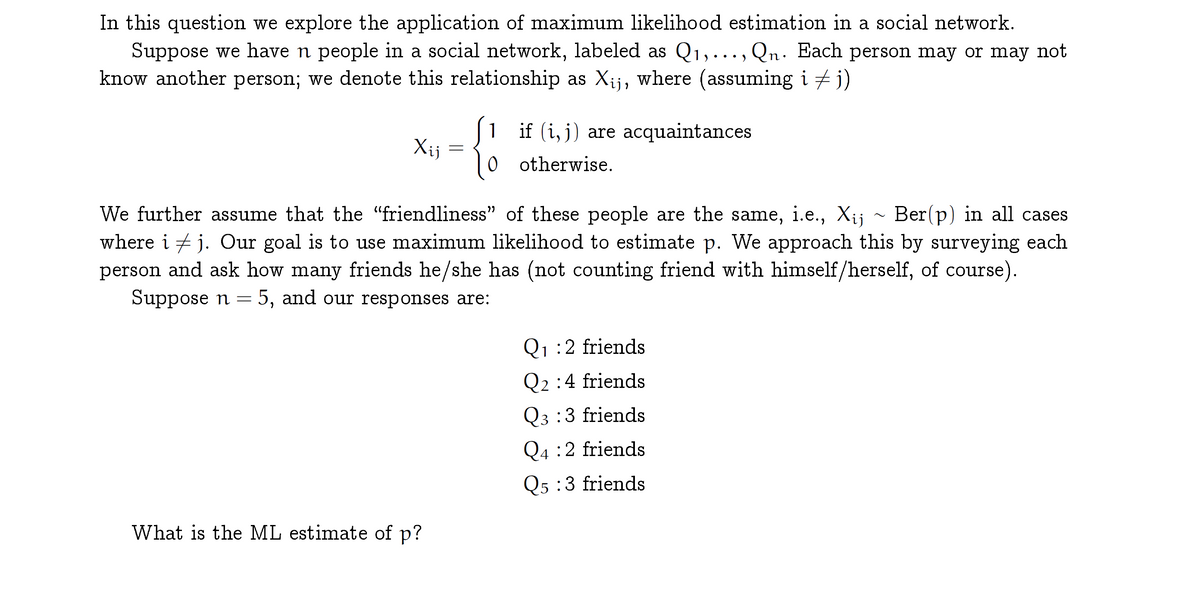In this question we explore the application of maximum likelihood estimation in a social network. Suppose we have n people in a social network, labeled as Q1,..., Qn. Each person may or may not know another person; we denote this relationship as Xij, where (assuming i #j) [1 if (i, j) are acquaintances Xij |0 otherwise. We further assume that the "friendliness" of these people are the same, i.e., Xij Ber(p) in all cases where i + j. Our goal is to use maximum likelihood to estimate p. We approach this by surveying each person and ask how many friends he/she has (not counting friend with himself/herself, of course). Suppose n = 5, and our responses are: Q1:2 friends Q2 :4 friends Q3 :3 friends Q4 :2 friends Q5 :3 friends What is the ML estimate of p?
In this question we explore the application of maximum likelihood estimation in a social network. Suppose we have n people in a social network, labeled as Q1,..., Qn. Each person may or may not know another person; we denote this relationship as Xij, where (assuming i #j) [1 if (i, j) are acquaintances Xij |0 otherwise. We further assume that the "friendliness" of these people are the same, i.e., Xij Ber(p) in all cases where i + j. Our goal is to use maximum likelihood to estimate p. We approach this by surveying each person and ask how many friends he/she has (not counting friend with himself/herself, of course). Suppose n = 5, and our responses are: Q1:2 friends Q2 :4 friends Q3 :3 friends Q4 :2 friends Q5 :3 friends What is the ML estimate of p?
Algebra & Trigonometry with Analytic Geometry
13th Edition
ISBN:9781133382119
Author:Swokowski
Publisher:Swokowski
Chapter10: Sequences, Series, And Probability
Section10.8: Probability
Problem 32E
Related questions
Question

Transcribed Image Text:In this question we explore the application of maximum likelihood estimation in a social network.
Suppose we have n people in a social network, labeled as Q1,..., Qn. Each person may or may not
know another person; we denote this relationship as Xij, where (assuming i + j)
) • ••
1
if (i, j) are acquaintances
Xij
otherwise.
We further assume that the "friendliness" of these people are the same, i.e., Xij ~ Ber(p) in all cases
where i + j. Our goal is to use maximum likelihood to estimate p. We approach this by surveying each
person and ask how many friends he/she has (not counting friend with himself/herself, of course).
Suppose n = 5, and our responses are:
Q1 :2 friends
Q2 :4 friends
Q3 :3 friends
Q4 :2 friends
Q5 :3 friends
What is the ML estimate of p?
Expert Solution
This question has been solved!
Explore an expertly crafted, step-by-step solution for a thorough understanding of key concepts.
Step by step
Solved in 2 steps with 2 images

Recommended textbooks for you

Algebra & Trigonometry with Analytic Geometry
Algebra
ISBN:
9781133382119
Author:
Swokowski
Publisher:
Cengage

College Algebra
Algebra
ISBN:
9781305115545
Author:
James Stewart, Lothar Redlin, Saleem Watson
Publisher:
Cengage Learning

Algebra & Trigonometry with Analytic Geometry
Algebra
ISBN:
9781133382119
Author:
Swokowski
Publisher:
Cengage

College Algebra
Algebra
ISBN:
9781305115545
Author:
James Stewart, Lothar Redlin, Saleem Watson
Publisher:
Cengage Learning